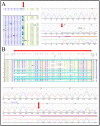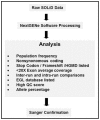Comprehensive mutation analysis for congenital muscular dystrophy: a clinical PCR-based enrichment and next-generation sequencing panel
- PMID: 23326386
- PMCID: PMC3543442
- DOI: 10.1371/journal.pone.0053083
Comprehensive mutation analysis for congenital muscular dystrophy: a clinical PCR-based enrichment and next-generation sequencing panel
Abstract
The congenital muscular dystrophies (CMDs) comprise a heterogeneous group of heritable muscle disorders with often difficult to interpret muscle pathology, making them challenging to diagnose. Serial Sanger sequencing of suspected CMD genes, while the current molecular diagnostic method of choice, can be slow and expensive. A comprehensive panel test for simultaneous screening of mutations in all known CMD-associated genes would be a more effective diagnostic strategy. Thus, the CMDs are a model disorder group for development and validation of next-generation sequencing (NGS) strategies for diagnostic and clinical care applications. Using a highly multiplexed PCR-based target enrichment method (RainDance) in conjunction with NGS, we performed mutation detection in all CMD genes of 26 samples and compared the results with Sanger sequencing. The RainDance NGS panel showed great consistency in coverage depth, on-target efficiency, versatility of mutation detection, and genotype concordance with Sanger sequencing, demonstrating the test's appropriateness for clinical use. Compared to single tests, a higher diagnostic yield was observed by panel implementation. The panel's limitation is the amplification failure of select gene-specific exons which require Sanger sequencing for test completion. Successful validation and application of the CMD NGS panel to improve the diagnostic yield in a clinical laboratory was shown.
Conflict of interest statement
Figures



References
-
- Hu H, Wrogemann K, Kalscheuer V, Tzschach A, Richard H, et al. (2009) Mutation screening in 86 known X-linked mental retardation genes by droplet-based multiplex PCR and massive parallel sequencing. Hugo J 3: 41–49 doi:10.1007/s11568-010-9137-y. - DOI - PMC - PubMed
-
- Hoischen A, Gilissen C, Arts P, Wieskamp N, van der Vliet W, et al. (2010) Massively parallel sequencing of ataxia genes after array-based enrichment. Hum Mutat 31: 494–499 doi:10.1002/humu.21221. - DOI - PubMed
-
- Muntoni F, Voit T (2004) The congenital muscular dystrophies in 2004: a century of exciting progress. Neuromuscul Disord 14: 635–649 doi:10.1016/j.nmd.2004.06.009. - DOI - PubMed
-
- Reed UC (2009) Congenital muscular dystrophy. Part I: a review of phenotypical and diagnostic aspects. Arq Neuropsiquiatr 67: 144–168. - PubMed
-
- Schessl J, Zou Y, Bönnemann CG (2006) Congenital muscular dystrophies and the extracellular matrix. Semin Pediatr Neurol 13: 80–89 doi:10.1016/j.spen.2006.06.003. - DOI - PubMed
Publication types
MeSH terms
Grants and funding
LinkOut - more resources
Full Text Sources
Other Literature Sources
Medical

